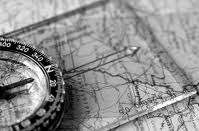How to Use a Compass to Navigate Without a Modern GPS

Learning how to use a compass is an essential skill for survival in any situation and in a post apocalyptic scenario where you need to leave markers for game trails and food caches, accurate compass bearings will provide you with easy to follow instructions. You will also need to make sure that everyone in your survival party can work a compass so that you can pass information easily between you.
Basic Pointers on How to Use a Compass
It's not hard to learn how to use a compass. As long as you're aware of the principles of magnetic north and know your four key directions of north, east, south and west, then you'll pick it up in no time. Here is a quick step-by-step guide on how to use a compass:
- Find north - every compass will have an arrow that floats around a dial. This is essentially a little magnet and because it can float freely, it will always point towards the north pole because of how the earth's magnetic field works.
- Consult your map - your map should be on a large enough scale that you can work out where you are from local landmarks like hills and rivers. You need to mark your intended route on the map before you set out from your base camp. The compass will show you which way is north, and you can then orient your map so you can see which direction to head in next.
- Check frequently - in closed terrains like woods, it can be very easy to veer from your intended path, so check your compass every couple of minutes to make sure that you're on the right bearing. This will stop you from going too far off course and wasting valuable time and energy.
Types of Compass
Once you've got the hang of how to use a compass, you then need to think about the best type of compass for your needs. Your decision will be largely influenced by how much travelling you'll be doing in unknown territory, how comfortable you feel operating a compass and how much money you're willing to spend. The three main types of portable compass are:
- Floating ball - these will attach to your belt or key chain easily and are very cheap to get hold of. The magnet is actually a painted ball that floats in liquid inside a plastic case so it will always be readable. The downside is that they are flimsy and can break easily. Expect to pay a couple of dollars.
- Orienteering - an orienteering compass comes on a hard piece of plastic. The compass itself traditionally sits at one end with detailed directional points around the edge. The other half of the compass gives you scale markers to help you read maps as well as a direction of arrow travel to help you match up your current direction on the ground and your intended direction on the map. A good one will cost you around $15 and they will last a little longer.
- Lensatic - lensatic compasses are designed with the US army in mind and are therefore built to resist temperature, wind, rain and falls. The lid of the compass comes with a sight wire so you can operate it with one hand. The sight wire also allows you to take a bearing on a landmark and read the compass at the same time. A lensatic compass will cost around $60 from an army surplus store.
The best way to learn how to use a compass and to find out which type you prefer is to get out and practice. Start by going to places that you know so that you won't get too lost if you make a mistake, and slowly graduate to unknown territory to put your skills to the test.
Return from How to Use a Compass to Survival Bug Out





New! Comments
Have your say about what you just read! Leave me a comment in the box below.